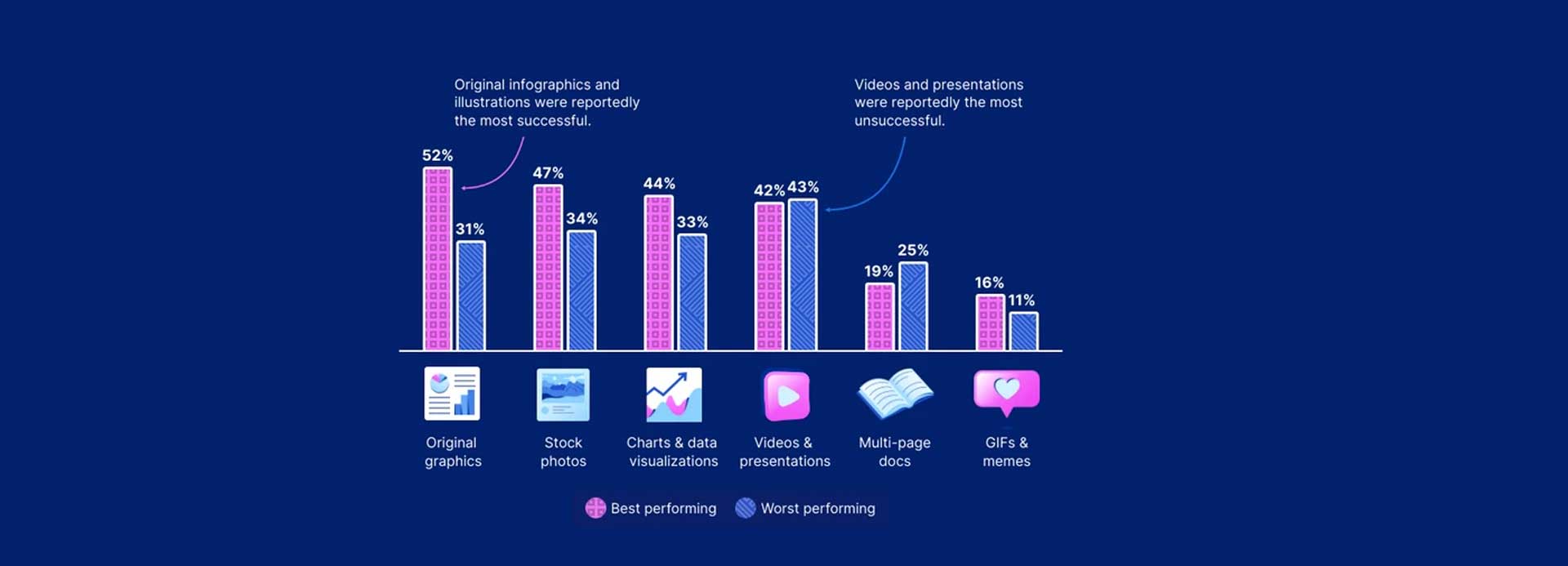

Forget the kids next door and the audience deceived by Zoom fatigue – 2023 was all about reinvention and rediscovery. Brands said goodbye to digital dust bunnies and refined their online presence, while creatives found their advocates and audiences found solace in scroll-worthy stories.
Yes, visual content is crucial in marketing. Visual elements play a significant role in capturing attention, conveying information quickly, and creating a memorable brand image. Humans are naturally drawn to visuals, and they can enhance the overall impact of marketing efforts. Different types of visual content are important, and their effectiveness may vary based on the platform and audience.
Key types of visual content used in marketing
1. Images and Graphics: High-quality images and graphics can quickly convey information and evoke emotions. They are commonly used in social media, websites, and various marketing materials. We can see many applications and services out there helping people create visual content with creative software on computers, laptops, tables, or smartphones.
2. Videos: Video content has become increasingly popular. It can be used for storytelling, product demonstrations, tutorials, and more. Videos are highly engaging and effective for conveying complex messages.
The power of visual marketing comes through when you pair it with a short story. Your message can be that much more powerful. – Ann Handley, Chief Content Officer
3. Infographics: Infographics combine text and visuals (as you can see below) to present information in a visually appealing and easy-to-understand format. They are great for communicating statistics, processes, or comparisons.
4. Interactive Content: This includes quizzes, polls, and interactive infographics. Interactive content engages the audience and encourages participation, making the marketing experience more immersive.
5. Memes and GIFs: These are often used on social media to convey humor, relatability, or specific emotions. They can be highly shareable and help in building a brand’s personality.
The most important type of visual content often depends on the target audience, the product or service being promoted, and the platform used for marketing. A well-rounded marketing strategy may incorporate a mix of these visual elements to cater to different preferences and engage a broader audience.
AI-generated content
AI-generated content is increasingly being used by brands as a part of their marketing strategy. Artificial Intelligence, particularly natural language processing models like OpenAI’s GPT, can generate human-like text, providing brands with new opportunities and efficiencies. Let’s look behind the scenes in which type of content is most generated
1. Content Creation: Brands use AI to generate written content for various purposes, such as blog posts, social media updates, product descriptions, and more. This can save time and resources while ensuring a consistent flow of content.
2. Personalization: AI can analyze user data to create personalized content experiences. This includes tailoring marketing messages, product recommendations, and email campaigns to suit individual preferences and behaviors.
3. Chatbots and Virtual Assistants: AI-powered chatbots and virtual assistants offer real-time interactions with customers. They can answer queries, provide information, and even assist in the purchase process, enhancing customer experience.
4. Ad Copy: AI can be used to generate ad copy for online advertising campaigns. This involves creating compelling and relevant text that resonates with the target audience.
5. Product Descriptions: AI can generate product descriptions by analyzing product features, benefits, and customer reviews. This ensures that descriptions are informative and appealing.
6. Social Media Management: AI tools can assist in managing social media accounts by suggesting content, posting updates, and analyzing engagement metrics.
While AI-generated content provides efficiency and scalability, it’s essential for brands to carefully monitor and review the output. Human oversight is crucial to ensure that the generated content aligns with brand values, maintains quality, and complies with ethical standards. Additionally, brands should be transparent about the use of AI-generated content to maintain trust with their audience.
Now collectively understand what can be done, let us have a look at the statistics in our Infographic provided by Venngage, 16 Visual Content Marketing Statistics to Know for 2024. Get ready for some fascinating insights and a glimpse of visual content marketing in 2024 and beyond.


![Which countries are winning the AI race [Infographic] hero-image-infographic-Digital-Evolution-Series-Part-1](https://www.skillzme.com/wp-content/uploads/2024/11/hero-image-infographic-Digital-Evolution-Series-Part-1-200x200.jpg)
![2024 Global Trends in AI [Infographic] 2024 Global Trends in AI](https://www.skillzme.com/wp-content/uploads/2024/11/hero-image-2024-global-trends-in-ai-infographic-200x200.jpg)
![A Visual Guide to AI Adoption by Industry [Infographic] hero-image-infographic-Digital-Evolution-Series-Part-2](https://www.skillzme.com/wp-content/uploads/2024/11/hero-image-infographic-Digital-Evolution-Series-Part-2-200x200.jpg)


Recent Comments